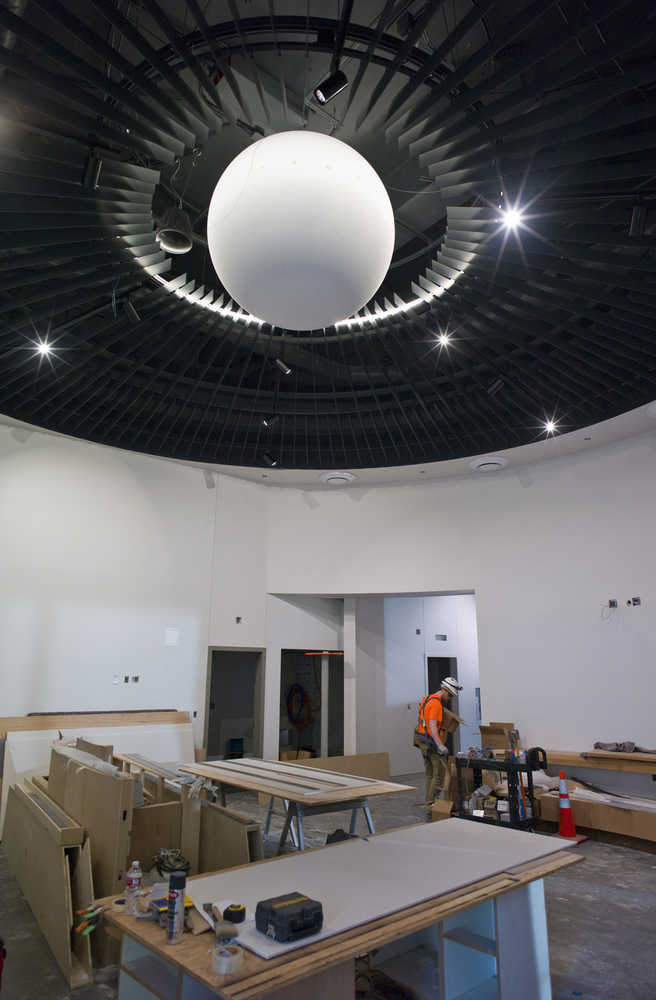Bob Banghart has a simple mantra for anyone who asks about the new State Library, Archives and Museum.
“On schedule, on budget,” he said. “I mean, I’ve had people come up to me on the street and say, ‘On schedule, on budget?’ and I’m like, ‘That’s it!’”
Being able to say that isn’t a small accomplishment. Adjusted for inflation, the $138.4 million building taking shape on a $2 million plot of land along Whittier Street is Juneau’s most costly capital project since the completion of the State Office Building.
At 118,000 square feet, it’s seven times as large as the (now demolished) Alaska State Museum and twice as large as the previous, separate, state archives, library and museum spaces combined. An underground parking garage adds another 64,000 square feet of space.
After almost 15 years of planning and construction (the land for the project was bought in 2002 and groundbreaking took place in 2013), it’s scheduled to be complete by the end of May, one year before the 150th anniversary of the Alaska Purchase.
Built on a thick concrete slab of sturdy materials, there’s a chance this new state museum might last until the 250th anniversary.
“It’s a hundred-year building,” Banghart said. “It’ll be around a lot longer than us.”
This month, Linda Thibodeau, director of the SLAM, hosted the Empire on a rare tour of the construction site. Accompanied by Banghart, the SLAM’s deputy director, and Jennifer Pepin, the project engineer, the Empire examined the progress of Juneau’s next landmark building.
“At this point in time,” Banghart said, accompanied by the grinding whine of power tools, “this is where we find out if our thinking has been correct, if our attentiveness to quality and accuracy has been correct.”
To save money, the SLAM is being run under a relatively new system by which its construction manager, PCL Construction, also serves as general contractor. On this project, PCL hired 15 subcontractors, with a labor force that peaked at 130 people.
“There’s anywhere from 50 to 75 guys on site now,” Banghart said.
As Pepin explained, the system lets subcontractors work in different areas of the project at the same time, rather than wait for all of the work in a particular stage to be finished out.
“Instead of waiting until everyone’s finished, it’s been a big mix,” Banghart said.
That was on display during the Empire’s tour as hard-hatted workers cut aluminum strips while down the hall, French-speaking Quebecois employees of Zone Display Cases put the finishing touches on hallway door-sized glass closets for artifacts.
“Right now, it’s like watching a bunch of rivulets come off a mountain and run into a stream,” Banghart said.
While the museum and library vaults have been completed and stocked with artifacts, only a few of the largest artifacts have yet made it onto the museum floor.
A Bristol Bay double-ender fishing boat sat near a snowmachine from the 1960s, not far from a locomotive pulled from the Alaska-Gastineau Mine. All were fattened by layers of plastic packing.
Along one wall was a cross-section of the trans-Alaska Pipeline, complete with dented radiators and support pilings.
The cross-section was specially built by Alyeska Pipeline Service Company in Fairbanks, then shipped to Juneau in pieces. The construction and shipping was all donated with no cost to the state.
Pointing to the pipeline segment, Banghart said it typifies the message of the new museum. “This is really no different than a spearpoint — it’s a little bigger — but the same construct in the human mind creates this. It’s all about how you adapt and develop the tooling to survive in the environment that you’re in.”
That message has the same meaning for the museum itself. While the last funding needed for construction was secured in April 2014 — before the state’s $3.5 billion budget gap became an immediate concern — it will open at a time when every dollar is precious to the state.
Banghart said those concerns — cost and efficiency — were accounted for in the design and construction of the museum.
When it opens, the building will hold 55 workers, the same number of staff that work in the existing, separate buildings.
“We’re running this with the same number of staff,” Banghart said, but because they all will be located in the same place, they’ll be working more efficiently.
In the four months before the building opens, there’s still plenty to be done. In the grand entrance hallway, the map of Alaska is only half-drawn. The exhibits have been planned, but none have been installed, and on the second floor — where the library will go — only blank floors and blank walls, draped by loose electrical wiring, greet visitors.
After the grand opening in May, there will be even more work — the City and Borough of Juneau is scheduled to install new utilities along Whittier Street — but by August, “things should be settled down.”
Until and unless things change, Banghart will keep his mantra close: “On time, on budget.”
“It’s been nice to be able to say that,” he said.
“It’s even better that it’s true,” Pepin added.
GET MORE
• For more on the design and layout of the new State Library, Archives and Museum, pick up next week’s Capital City Weekly, inserted into your Thursday Juneau Empire or available on racks throughout Southeast Alaska.
• To follow with the Empire on a digital tour of the construction site, visit juneauempire.com and find the slideshow accompanying this story.

